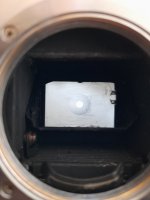to expand
35mm is cannister film. Generally you load the exposed tail of the film in the canister onto the take up mechanism and shoot to the end of the roll, winding on after each frame. At the end, you disengage the film take up mechanism, and rewind the film into the cannister. You then remove the cannister.
Some 35mm cameras (usually the later dated compacts) will actually pull the entire roll of film onto the takeup spool when you load the camera, and each frame you take, the picture is actually wound INTO the cannister. This is a good thing in a way because if the back of the camera is opened, any exposed photo's are safely inside the cannister. Of course ALL the rest of the film is knackered, but at least hopefully you've not lost any pictures, just the chance of any more.
120 film is Roll Film, It comes on one film spool, and you need another one in the camera (or film back). You load the open end of the backing paper onto the empty spool, and shoot, winding on each time. At the end, you've wound all the film off the original spool and onto the takeup spool. Seal the end of the takeup, and send it for processing, moving the now empty spool to the takeup position for the next roll. No Winding back into the original involved.



